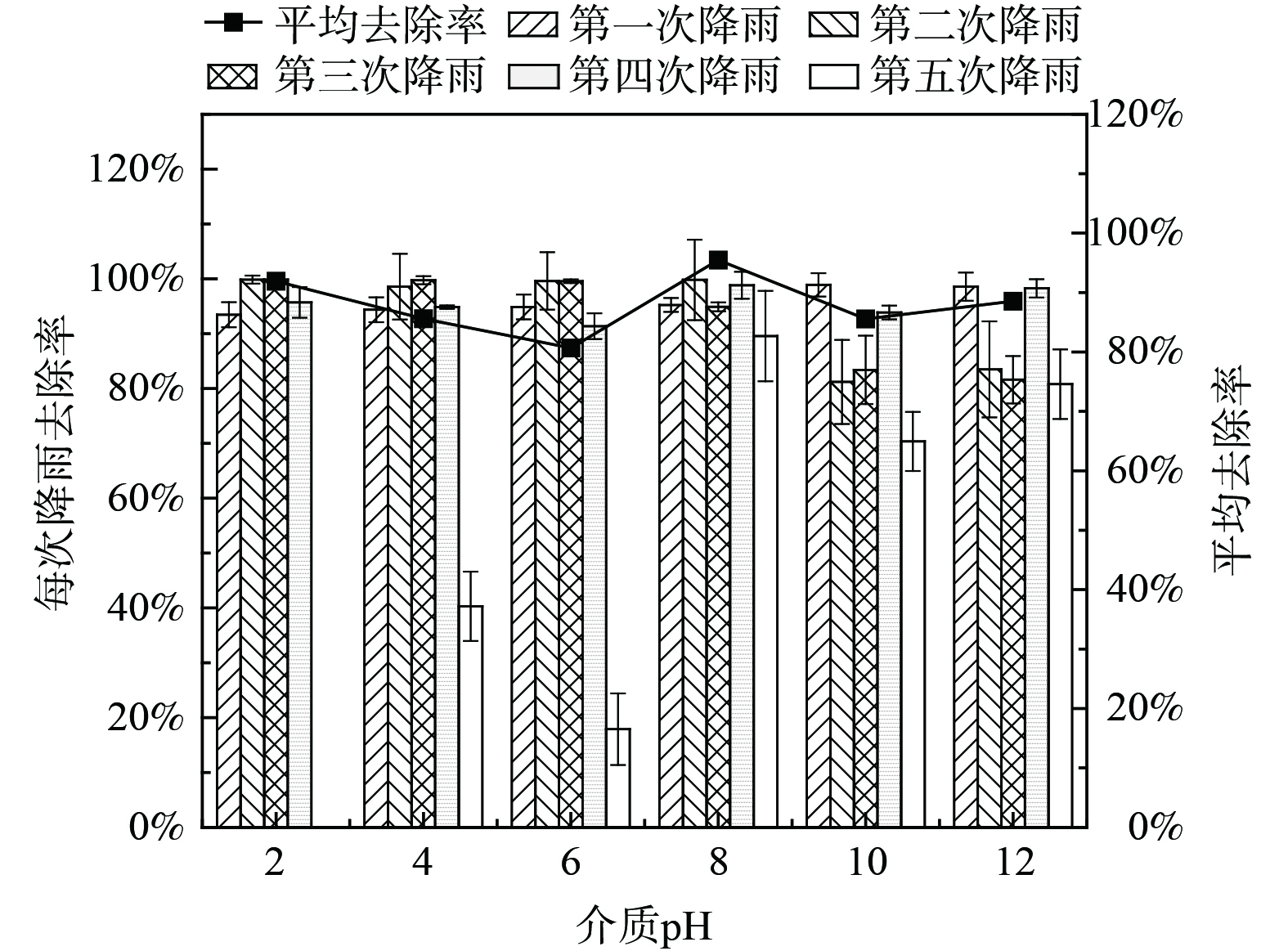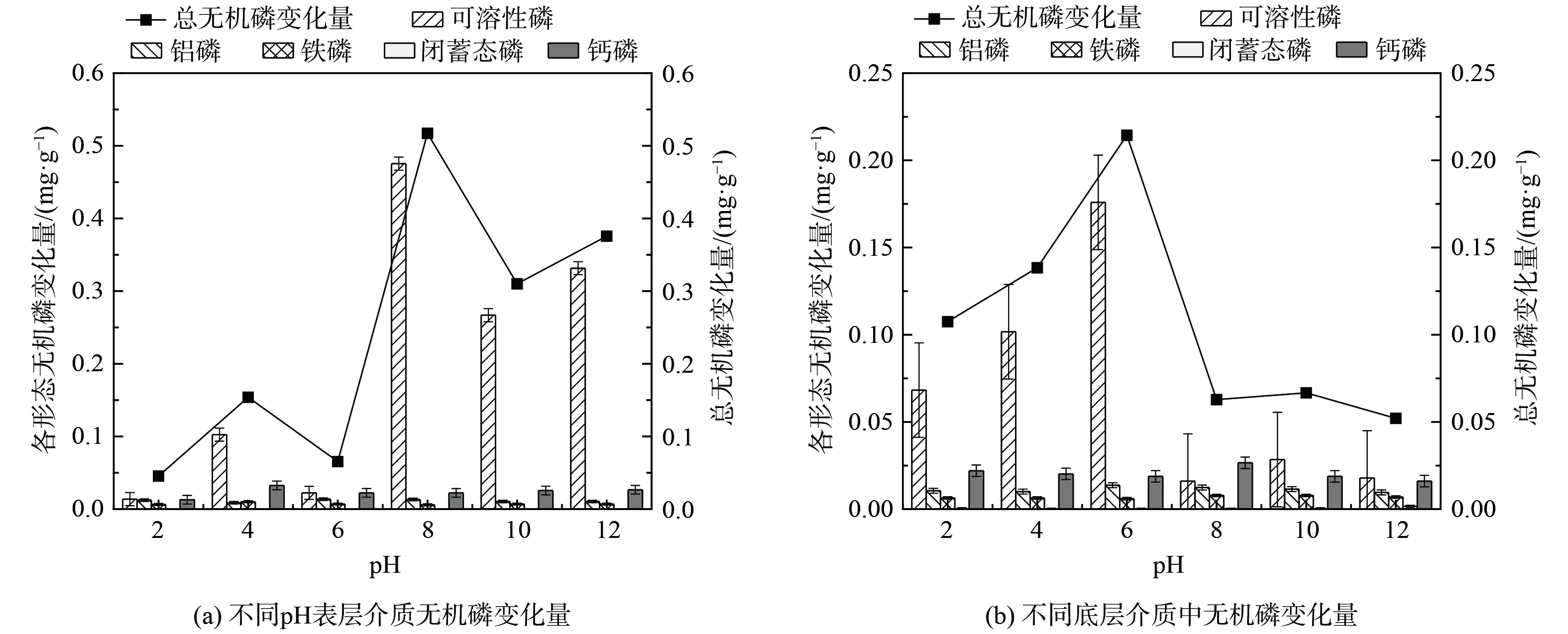-
城市地表径流是城市地表水体的主要水量补给[1],其中含有人类活动和自然过程产生的许多污染物,包括氮磷等营养物质、有毒有机物、重金属、悬浮固体、油、有机碳和致病菌[2]。植物滞留系统作为一种低影响开发 (low impact development,LID) 雨水管理措施,最初提出并应用于美国马里兰州乔治王子县,后来这项技术被称为雨水花园和生物渗透,并以最多样化的形式迅速成为最常用的最佳管理措施[3]。尽管该技术在控制水质方面具有重要意义,但在以前的研究中仍不能完全控制住磷的排放[4-5]。
关于生物滞留系对P去除影响的研究主要集中在不同过滤材料上[6],如 LI等[7]研究了医疗石、蛭石、泥炭土等6种填料介质对磷的去除效果发现,添加水处理残渣对总磷 (TP) 和可溶性活性磷 (SRP) 具有最佳去除率。但进一步深入研究发现一些效果不好的材料中仍会有磷浸出。由于雨水的冲刷或有机材料如堆肥、泥炭或地膜等的腐烂亦会造成磷浸出[8][9]。与纯砂子介质的植物滞留系统相比,在介质中加入少量有机质可提高磷的去除率[10]。在介质中直接加入铝和氧化铁,可显著促进磷沉淀[11]。雨水中大多数磷为颗粒态,且TP流出浓度通常与总悬浮固体 (TSS) 流出浓度相关[12],介质中的不同形态磷对富营养化的作用有所差异,生物对不同形态磷的吸收利用也不同。植物滞留系统的主要除磷机制是沉积物吸附[13-14],其中正磷酸盐PO4−3-P与金属离子 (Fe、Al、Ca) 发生化学反应,形成不溶性化合物沉淀并在水中去除[15]。关于介质中磷形态的研究越来越多,大多数磷以无机磷形态存在于介质中。钙磷是其中的主要成分,有机磷所占比例较少。至今为止,无机磷分为水溶性磷、铁磷、铝磷、钙磷、闭蓄态磷等。其中正磷酸盐是溶解磷的主要形式,可直接被植物捕获[16],也可通过过滤介质吸附以降低溶解态磷的浸出。土壤中溶解态磷去除的过程包括吸附、沉淀和离子交换[17]。但对有机磷的研究进展则较慢,形态分级较为粗略。
已有不少学者提出使用各种添加剂,如粉煤灰、膨胀页岩、生物炭、浮石、铁屑或铁丝,以提高对磷的吸附能力,从而提高其去除率[17]。然而,目前关于土壤介质添加剂的添加量对介质去除磷污染物效果的影响及各形态磷含量变化情况鲜有报道。本研究以盆栽与柱实验为主要手段,对填料层增添不同添加剂改良介质和改变pH条件后对磷的去除效果及介质中各形态磷转化进行研究,探讨了影响各形态磷含量的主要因素。使植物滞留系统能在降低雨水浓度及去除雨水径流中的污染物方面发挥更好的作用,以期为植物滞留系统的设计提供参考。
-
淀粉和葡萄糖购买于呼和浩特市新城区科宇百通科研用品。淀粉为可溶性淀粉,示性式为(C6H10O5)n,n≈2;葡萄糖,分子式C6H12O6·H2O。实验试剂均不含磷杂质。粉煤灰来源于燃煤电厂,各成分所占百分比为SiO2 56.743%; Al2O3 24.589%;Fe2O3 6.552%;CaO 4.866%; TiO2 1.865%。在砂土与粉煤灰的混合介质中,有机磷及无机磷的本底值质量分数见表1。
盆栽实验及柱实验中使用的土壤来源于呼和浩特市托克托县双河镇郝家窑村河边的砂土。该地区土壤无污染,将砂土中的杂物 (植物残根及砾石等) 剔除。装入收纳袋后,将砂土带到实验室,砂土过筛 (2.0 mm) 后备用。实验使用的土壤,粒径分析结果为砂砾 (1~0.05) −90%;粉粒 (0.05~0.01) −2%;粘粒 (<0.01) −8%。根据国际制土壤质地分级标准,该砂土被称为砂土及砂壤土。
-
1) 土壤介质添加剂对磷去除效果及磷形态转化规律研究。盆栽实验中土壤介质添加剂有:葡萄糖、淀粉、粉煤灰。基于呼和浩特当地的实测值4.76 mg·L−1将人工模拟降雨雨水的质量浓度设置为5 mg·L−1 (以磷计,由分析纯的KH2PO4配制) 。
在传统的脱氮除磷工艺中,聚磷菌和反硝化菌进行反应时均需要利用碳源。因此,当碳氮比较小的情况下,碳源将成为限制性因素,而葡萄糖与淀粉可提供大量碳源,且淀粉分子量大可增加介质渗透能力与污水接触时间。向介质中适当增加Ca、Al和Fe可提高其吸附去除磷的能力,而粉煤灰中亦含有这些金属的氧化物。植物滞留系统的主要介质为砂土。在砂土中分别添加葡萄糖、淀粉、粉煤灰3种土壤介质添加剂,添加量分别为0%、2%、4%、6%、8%、10% (体积分数),使之混合均匀。准备17个直径为15 cm,高度为20 cm的PVC花盆,在底部铺两层医用纱布。将准备好的介质填充到PVC花盆中。使用喷壶将配置好的体积为2 L,质量浓度为5 mg·L−1的磷溶液分别均匀的喷洒到PVC花盆中。每隔3 d降一次雨,模拟人工雨水5次,测量每次的出水体积及出水质量浓度,计算每次模拟降雨的去除率,最后再测量各组介质中各形态磷含量。结合实验现象,确定土壤介质添加剂的选择及土壤介质添加剂的最佳添加量。使用Bowman-Cole法、Peterson和Corey法对植物滞留系统不同深度基质中的磷形态进行了分级提取。
2) 改变雨水pH对磷去除效果及磷形态转化规律研究。准备6个直径为15 cm,高度为20 cm的PVC花盆。在底部铺两层医用纱布,向其中分别填充1 500 mL的土壤。人工模拟降雨雨水质量浓度为5 mg·L−1 (以磷计,由分析纯的KH2PO4配制) ,雨量为2 L,并将溶液pH分别调至2、4、6、8、10、12。使用喷壶将已配置的不同pH磷溶液均匀喷洒至花盆中。 每隔3 d降一次雨,模拟雨水5次,测量每次的出水体积及出水质量浓度,计算每次去除率,最后再测量各组介质中各形态磷含量。根据实验结果确定最佳pH。
3) 植物滞留柱不同深度磷污染物去除率及磷形态转化规律研究。每组实验装置均由直径为20 cm,高度为125 cm的PVC植物滞留柱组成,在植物滞留柱不同高度 (20 cm、40 cm、60 cm、80 cm、100 cm) 设置外排水管出水口控制装置。柱子底端的收集雨水装置采用塑料盆收集。植物滞留柱实验装置见图1。
在上述优选实验研究结果的基础上,构建3组植物滞留柱。柱中介质分别添加砂土、砂土+2%淀粉、砂土+4%粉煤灰。在PVC管内壁用砂纸粗糙化,以便提高PVC管内壁摩擦力,减少实验误差。PVC管最底端填充直径为1.0~1.5 cm的碎石,填充高度为10 cm,并在其上层填充高度为5 cm直径为0.2~0.25 cm的粗砂,然后在粗砂层上面的填料层填充已确定好的介质。每个柱子的降雨量为10 L ,降雨时间为4 h (中雨17.5 mm·d−1,汇水面积为5%) 。每次降雨时间间隔为6 d,共降雨9次。每次模拟降雨实验中,在不同深度 (20 cm、40 cm、60 cm、80 cm) 处取10 mL流出物并测量其磷浓度,在最底端出水口测量出水质量浓度及总出水体积,并计算柱底端每次降雨的去除率。在模拟降雨结束后,使用Bowman-Cole法、Peterson和Corey法对植物滞留系统不同深度基质中的磷形态进行分级提取。
-
当土壤介质添加剂为葡萄糖、淀粉与粉煤灰时 (图2) ,淀粉+砂土的混合物对磷的去除率明显要比空白实验组去除率高,另外两组与对照差别不大。添加粉煤灰实验组介质对磷的去除率均比较高,而且相对稳定,去除率均达到86%以上。然而,砂土对磷的去除率随着降雨次数的增加而快速降低,去除率变化较大,这一现象与HSIEH[18]观察到的一致。添加葡萄糖时,随着降雨次数的增加,去除率呈现出降低的变化趋势,第3次模拟降雨之后去除率相对稳定。随着淀粉添加量的增加去除率的变化没有明显提高。随着降雨次数的增加,各组中介质对磷的平均去除率随粉煤灰添加量的增加呈递增趋势。这说明使用粉煤灰作为土壤添加物对生物滞留系统的磷去除及稳定化具有实际意义。
从实验过程来看,淀粉作为土壤介质添加剂时,随着淀粉添加量增加,底部流出水速率越慢,但添加量的增加对磷去除率影响不大,呈现出略微递增的变化趋势。这可能是由于淀粉遇水变为胶状物质,混合到土壤中能减缓雨水的下渗,从而增大了磷溶液与介质的接触时间,进而能更好地吸附磷。在添加粉煤灰后,介质的去除率明显升高,并且介质对磷的去除率随着粉煤灰添加量的增加而升高。由于粉煤灰中含有各种活性较高的组分,使其成为最适合水中磷净化的材料之一。粉煤灰中富含钙、铁、铝氧化物,这些金属氧化物可将水中的磷强烈吸附或与磷发生沉淀,从而使磷的去除效果得到改善[19]。随着粉煤灰的添加量增加,水流下渗速率同样有所减慢,尤其是添加量为8%、10%时,雨水的下渗速率明显更低。这可能是由于粉煤灰的添加,将土壤介质颗粒间较大的孔径堵塞,导致了介质渗透性降低。介质对磷的去除效果受接触时间的影响,开始随着接触时间的增长,从而导致介质对磷的吸附量增多,去除效率也随着提高[20]。植物滞留系统的作用之一是削减雨水径流总量和洪峰流量,并推迟洪峰流量的出现时间。综上所述,淀粉、粉煤灰作为土壤介质添加剂的实验组处理效果更好,最佳淀粉添加量为2% (体积分数) 。当粉煤灰添加量为2%和4%时,盆栽底部出水速率基本相同且相对较快,故粉煤灰最适添加量为4% (体积分数) 。
经过模拟降雨后,表层介质中无机磷的质量分数变化如图3 (a)~(c) 所示。选用淀粉作为土壤介质添加剂时,表层介质中钙磷质量分数增加较大。随着淀粉添加量的增加,介质中钙磷的变化量出现了先增大后降低的变化趋势,并且在添加淀粉后,主要发生可溶性磷向钙磷转化过程。当选用葡萄糖作为土壤介质添加剂时,钙磷质量分数的增加量相对较小,铝磷及闭蓄态磷的质量分数变化均相对稳定,出现了少量增加。这表明添加葡萄糖时介质中无机磷主要以可溶性磷向铁磷转化,葡萄糖有利于铁磷的转化。在以粉煤灰作为土壤介质添加剂时,介质中钙磷和铝磷质量分数的增加,是由于添加粉煤灰后混合介质中的钙氧化物和铝氧化物的增加所致。随着粉煤灰的添加量的增加,介质中钙磷、铝磷的增加量呈明显增大趋势,并且介质中钙磷的增加量明显大于铝磷。然而,添加粉煤灰中铝氧化物的占比要大于钙氧化物,导致这一反差现象的原因可能是由于在石灰性土质中,存在着铝磷向钙磷的转化过程[21]。闭蓄态磷质量分数基本上没有明显变化。
在底层介质中,无机磷的质量分数变化如图3 (a)~(c) 所示。与空白实验相比,选用淀粉作为土壤介质添加剂时,底层介质中的铁磷质量分数略微增大,钙磷的增加量呈现出略微降低的变化趋势,水溶性磷质量分数呈现出递增的变化趋势。铝磷及闭蓄态磷增加量较多。选用葡萄糖作为土壤介质添加剂时,介质中的水溶性磷增加量较大,并且随着葡萄糖添加量的增加,介质中的水溶性磷和铁磷质量分数的增加呈现降低的变化趋势。在底层介质中,钙磷的增加量与葡萄糖添加量为负相关。在添加粉煤灰介质中,钙磷、铝磷均有增加,可溶性磷少量增加,这主要是由于粉煤灰介质中钙氧化物较多且钙磷是难溶性物质,在底部以磷酸盐的形式存在,故介质中P向水体释放的作用较小[22]。介质中的水溶性磷质量分数随着粉煤灰添加量的增加而呈现逐渐降低趋势,在粉煤灰添加量为6%~10% (体积分数) 时,介质中的水溶性磷质量分数基本保持不变。这说明粉煤灰的添加促进了水溶性磷向其他形态磷的转化,尤其是向钙磷转化。 当选用淀粉、葡萄糖作为土壤介质添加剂时,介质中的铁磷增加量相对较大,而在选用粉煤灰时基本上没有明显变化。导致这一现象的原因可能是:添加葡萄糖、淀粉导致氧化还原电位升高。当氧化还原电位升高时,介质中的Fe2+转化为Fe3+,使Fe3+与磷结合生成难溶的磷盐随之沉淀。且在添加葡萄糖时,随着添加量的增加,介质中铁磷的增加量呈现出递增的变化趋势。这说明葡萄糖添加量的增加有利于铁磷质量分数的增加。葡萄糖可促进转化和利用根际土壤无机磷中铝磷、铁磷[23]。添加粉煤灰的混合介质中总无机磷增加量明显增大。这可能是由于粉煤灰中含有大量Al、Ca离子,增强了对磷的吸附形成了大量的铝磷,钙磷等,且钙磷是难溶性物质,在底部以磷酸盐的形式存在,故介质中P向水体释放的作用较小[24]。同时,介质中的水溶性磷质量分数随着粉煤灰添加量的增加而呈现出先减小后略微增加的变化趋势,在粉煤灰添加量为6%~10%时,介质中水溶性磷的增加量基本保持不变。这说明粉煤灰的添加促进了水溶性磷向其他形态磷的转化,尤其是向钙磷的转化。与表层介质相比较,底层土壤介质中最明显的变化为钙磷质量分数的增加。导致这一现象的原因可能是由于表层中有足够CO2,使溶液中H+增加,增大了钙磷的可溶性,促进钙磷的释放而导致的这一明显差异[25]。
对于有机磷的变化如图4所示。对于添加淀粉和葡萄糖的表层介质中的中等活性有机磷均会向活性有机磷转化。介质中的稳定有机磷和中等稳定有机磷变化量均减少,并且随着葡萄糖、淀粉添加量的增加,其质量分数基本保持不变。这说明葡萄糖、淀粉添加量的改变对介质中的稳定有机磷和中等稳定有机磷质量分数变化情况没有明显影响。对于表层介质,粉煤灰添的添加,主要使介质中的中等活性有机磷向活性有机磷与稳定有机磷和中等稳定有机磷转化。这说明粉煤灰有助于活性有机磷含量的增加,并且表明粉煤灰添加量与中等活性有机磷的转化没有明显的相关性。
在底层介质中有机磷变化情况如图4 (b)~(d) 所示。在添加淀粉时,各组介质中的有机磷出来活性有机磷均略微减少,但与对照相比总有机磷减少。这可能是由于淀粉的添加增加了活性有机磷向无机磷的转化。当添加介质为葡萄糖时,介质中的活性有机磷和中等活性有机磷质量分数没有明显变化。当葡萄糖添加量为4%和10% (体积分数) 时,介质中的中等活性有机磷增加,而在添加量为2%、6%和8% (体积分数) 时,中等活性有机磷减少。并且,各组介质中稳定有机磷质量分数的减少量都大于中等活性有机磷质量分数的减少量。同时,葡萄糖也有利于有机磷向其他可溶性磷转化。在添加粉煤灰后,各组介质中的活性有机磷质量分数均增加中等活性有机磷质量分数均减少。这说明粉煤灰有助于其他形态磷向活性有机磷转化,且中等活性有机磷易于转化。对于介质中的中等稳定有机磷质量分数,只有在粉煤灰添加量为4%、6% (体积分数) 出现了略微增加,在粉煤灰添加量为0、2%、8%和10% (体积分数) 时,介质中的中等稳定有机磷含量略微减少。这表明粉煤灰添加量与中等稳定有机磷质量分数变化情况没有明显相关性。当粉煤灰添加量为2%~6% (体积分数) 时,随着粉煤灰添加量的增加,介质中的稳定有机磷质量分数增加量呈现出降低的变化趋势;在粉煤灰添加量为8%~10% (体积分数) 时,介质中的稳定有机磷质量分数减少。这说明添加粉煤灰不利于介质中的磷以稳定有机磷形态存在。
添加葡萄糖与淀粉,会促进介质中其他有机磷形态向活性有机磷转化,并且随着淀粉、葡萄糖的添加量的增加,其质量分数变化情况基本保持不变。这说明电子供体的改变对介质中的稳定有机磷和中等稳定有机磷的质量分数变化情况没有明显影响。这可能是由于有机物的添加为微生物生长提供了丰富的碳源和矿物质,从而提高了微生物、磷酸酶等的活性,促进了有机磷的转化,最终促进了难利用磷库向有效磷库的转化[26-27]。当粉煤灰为添加介质时,表层介质中的活性有机磷增加量先增大之后基本保持不变。当粉煤灰添加量为6% (体积分数) 时,活性有机磷增加量最大,介质中的中等活性有机磷均表现出减少现象,在粉煤灰添加量为2%和10% (体积分数) 时,减少量达到了最小值和最大值,中等稳定有机磷均表现出质量分数增加的现象;当粉煤灰添加量为6%和2% (体积分数) 时,介质中的中等稳定有机磷质量分数增加量分别达到了最小值和最大值。这说明粉煤灰有助于活性有机磷含量的增加且活性有机磷的增加可能是由于中等活性有机磷的转化,同时还存在中等活性有机磷向中等稳定有机磷的转化表明粉煤灰存在不利于中等活性有机磷的保持。稳定有机磷质量分数没有明显的变化规律,在粉煤灰添加量 (体积分数) 为0、2%、6%、8%时,介质中的稳定有机磷质量分数出现了减少现象,在粉煤灰添加量 (体积分数) 为8%时减少量最大。这可能是由于粉煤灰中含有的Al和Fe等金属离子提供了大量的金属-有机键的结合位点,这个过程提高了介质对有机磷的保持力[27]。
-
改变人工模拟雨水pH时,随着pH的增加,介质对磷溶液的去除率呈现出降低的变化趋势 (图5) 。当pH为8时,介质对磷的平均去除率达到最大值,去除率为95.45%。土壤pH本底值是8,经过降雨后各实验组中土壤pH的变化情况为降雨前分别为2、4、6、8、10、12,降雨后分别为5、 5、5、8、 8、10。这说明土壤对pH 的调节有一定缓冲能力,使土壤pH趋于中性。
改变人工模拟雨水pH时,对于表层介质 (图6 (a) ) ,在酸性范围内,水溶性磷质量分数增加量均相对较少。在模拟雨水为碱性时,介质对磷的去除率均较高,且介质中的水溶性磷质量分数增加幅度最大。这说明介质在碱性环境下有利于对磷的吸附,且吸附到介质中的磷主要以水溶性磷的形态存在于介质表面。无论在酸性还是碱性条件下,介质中铝磷、铁磷、钙磷的质量分数增加量均较小,随着pH的改变,增加量没有明显变化。除了pH为4的条件外,其他各形态无机磷增加量由大到小的排序为水溶性磷>铝磷>钙磷>铁磷,其中闭蓄态磷质量分数均没有发生变化。
当改变人工模拟雨水pH时,底层介质 (图6 (b) ) 中水溶性磷与表层介质中磷的增加量出现了相反现象。这可能是由于在酸性条件下表层介质对磷的去除率较低,使得雨水径流到底层时含有较高磷浓度,而高浓度环境有利于介质对磷的吸附,使得介质中含有较高的水溶性磷。在碱性范围内,介质中的水溶性磷质量分数增加量相对较小。对于底层介质,钙磷质量分数增加量基本低于水溶性磷质量分数的增加量。当pH为8时,底层介质中钙磷质量分数增加最大,并且高于介质中水溶性磷质量分数的增加。除pH为8外,介质中的各形态磷质量分数增加量由大到小的顺序依次为:水溶性磷>钙磷>铝磷>铁磷>闭蓄态磷。这表明pH 为8是系统的最佳pH条件。综上所述 ,与表层介质相比,底层介质存在于厌氧环境,在厌氧环境下钙磷的增加量仅次于水溶性磷;而在酸性环境中,底层介质中水溶性磷质量分数的增加量所占比明显高于其他形态磷质量分数的增加量;这表明酸性雨水径流更容易造成地表水的污染。
在酸性降雨之后,介质中活性有机磷质量分数增加量都比较小,但在碱性环境下,随着pH的增加,介质中的活性有机磷质量分数呈现出降低趋势 (图7 (a) ) 。对于介质中的中等活性有机磷和稳定有机磷质量分数均表现出减少现象,且其中的中等活性有机磷质量分数减少幅度最大。这说明在pH小于10的碱性环境下,介质中有机磷多以活性有机磷存在,且中等活性有机磷易于向活性有机磷 转化。其中,稳定有机磷质量分数均表现出略微减少的现象。除了pH为4时,中等稳定有机磷质量分数均表现出微弱减小。而在介质中除了活性有机磷质量分数增加外,其他形态磷的质量分数均表现出减少现象,其质量分数减少量由大到小的顺序为:中等稳定有机磷>稳定有机磷>中等稳定有机磷。
底层介质 (图7(b)) 中活性有机磷质量分数均表现出增加趋势,而介质中中等活性有机磷、中等稳定有机磷、稳定有机磷质量分数则呈现减少趋势。随着pH的改变,介质中各形态有机磷质量分数并没有明显变化。这是由于在土壤本身缓冲作用下,不同pH雨水进入植物滞留系统底层会被调节至弱碱性,从而使得不同实验盆中的底层介质呈现出相同环境条件。其中,各有机磷形态质量分数减少量由大到小的变化排序为中等活性有机磷>稳定有机磷>中等稳定有机磷,与表层变化情况相同。
当系统pH变化时,酸性碱性都不利于系统对磷的去除,相对来说碱性更有利于系统对磷的去除。这是由于当pH较低时,主要通过Al和Fe等作用将磷酸盐吸附沉淀易解析,当环境变为偏碱性条件时,其中的Ca对磷酸根的吸附和沉淀发挥作用。磷酸根会首先被土壤中的 CaCO3吸附,随后与钙离子发生反应生成二钙型磷酸盐[CaHPO4],二钙型磷酸盐[CaHPO4]会继续转化为更稳定的八钙型磷酸盐[Ca8H2(PO4)]和十钙型磷酸盐 [Ca10 (PO4)6(OH)2][19]。而Ca-P作为一种难溶性的物质,以磷酸盐的形式存在,为惰性磷组分,不易被生物吸收利用,较难与活性磷成分进行形态转化,因此也不易在填料中进行上下层间的迁移,从而使系统对磷的去除率有所提高[24]。在酸性和碱性条件下,表层介质中水溶性磷质量分数均增加,且碱性环境下增加较大。这说明碱性环境有利于介质对磷的吸附,且被吸附磷主要以水溶性磷的形式存在于介质表面。与表层介质相比,底层介质主要是水溶性磷和钙磷质量分数增加最大。这可能是由于在厌氧环境下钙磷增加量仅次于水溶性磷;而在酸性范围内底层介质中水溶性磷质量分数增加量所占比明显高于其他形态磷质量分数的增加,这表明酸性的雨水径流更容易造成地表水的污染。对于有机磷形态,表层活性有机磷新增加与其他有机磷形态变化相对较大,底层介质中活性有机磷质量分数增加,但中等活性有机磷、稳定有机磷、中等稳定有机磷质量分数依次减少,且随着pH的改变,介质中的各形态有机磷质量分数并没有明显变化。这可能是由于不同pH的雨水径流进入到植物滞留系统的底层时,均被调节至弱碱性,使得不同实验盆中的底层介质处于相似环境条件。
-
盆栽实验结果表明,淀粉、粉煤灰在柱实验中的添加量分别为2%和4% (体积分数) 时效果最佳。随着深度的增加,砂土、砂土+淀粉、 沙土+粉煤灰这3组实验柱中的平均出水磷质量分数均呈现递减趋势 (图8 (a)~(c)) 。底端去除率表明 (图8(d)) ,砂土+粉煤灰、砂土实验组对磷的平均去除率相对较大,达到了94%以上;砂土+淀粉实验组去除率最低,平均去除率为86.5%。随降雨次数的增加,每个实验柱对磷的去除率基本稳定。这是由于降雨总磷相对较多,介质已吸附了大量磷酸盐。但由于柱中填充了大量介质,底部介质中还有大量磷酸盐吸附位点供磷吸附,从而导致每次底端的出水质量分数均很小。但对于深度较浅的位置出水质量分数变化比较明显,随降雨次数的增加出水质量分数会出现增加趋势。
当深度为20 cm和40 cm时,粉煤灰组的平均出水质量分数最低,砂土及砂土+淀粉2组相差不大。在砂土、砂土+粉煤灰实验组的出水质量分数在深度为60 cm、80 cm、100 cm时缓慢降低,且随着深度增加表现出递减趋势,去除率均达到91%以上。然而,在深度为60~100 cm时,砂土+淀粉组的出水磷质量分数呈现出缓慢递减趋势,且在60 cm、80 cm和100 cm时磷去除率均小于砂土、砂土+粉煤灰实验组。因此,从实验室规模的系统来看淀粉作为添加剂效果较差。淀粉作为电子供体有利于提高对磷的去除,但在柱实验当中,淀粉+土壤混合介质与土壤介质相比表现出相反的实验现象。随着降雨次数的增加,柱实验的降雨量由2 L增至10 L,淀粉+土壤混合介质对磷的平均去除率小于土壤介质。这说明水力负荷的增加会导致介质对污染物的去除率降低,尤其是对土壤+淀粉混合介质影响较为明显。导致去除率降低的原因可能是在较小的水力负荷条件下,能增加雨水径流与介质的接触时间,使净化效果得到改善。底端去除率的变化表明,添加粉煤灰实验组及土壤实验组对磷的平均去除率相对较大,去除率均达到了95%。因此,粉煤灰作为生物滞留系统介质添加剂对进一步提高形态对磷污染物的去除有重要意义。
图9 (a) 、 图10(a)和(b)表明了不同深度下3种植物滞留系统介质中无机磷形态的变化。随着深度的增加,土壤介质中水溶性磷质量分数逐渐减少,而表层介质中水溶性磷质量分数最高;但介质中铝磷的质量分数均减少,且出水铝磷质量分数未发生明显变化;介质中的铁磷质量分数均增加,而出水铁磷质量分数的增加量呈现先降低后增加的趋势。这可能是由于铝磷很容易从介质中溶出 ,而水中有很多化合物可作为其提取剂 ,而铁磷则相对更难释放 。在相当一段时间内 ,铝磷与铁磷存在一个转化过程 ,介质中的铝磷将逐渐转化成铁磷[28]。而介质中闭蓄态磷和钙磷的质量分数均表现出增加趋势。当深度为40~80 cm时,介质中钙磷的质量分数变化情况基本保持不变。
向砂土中添加淀粉 (图10 (a) ) 的条件下,当深度为0~60 cm时,介质中水溶性磷的质量分数随着深度的增加而降低,并在深度为60 cm处表现出变化量减少的现象。介质中铝磷的质量分数均减少,且随着深度增加介质中铝磷的质量分数减少量呈现递增趋势。表层介质中的铁磷质量分数增加最低。在20 cm处,铁磷质量分数突然增大,随着深度增加,介质中的铁磷质量分数增加量基本保存不变。这可能是由于添加淀粉后氧化还原电位升高,使得难溶性 Fe(OH)2不易变成可溶性 Fe(OH)3,铁离子继续以Fe3+存在 ,而Fe3+易与P结合,故与铁结合的磷并未释放入水体[27]。闭蓄态磷的质量分数在0~40 cm处增加量较小、在60~80 cm处增加量较大,这说明厌氧环境有利于闭蓄态磷的形成。随着深度增加,介质中钙磷质量分数增加量呈现先减小后增加的趋势。在40 cm处,介质中钙磷质量分数增加量最小。同时添加淀粉可使介质中铝磷质量分数减少,这可能是由于介质中存在着铝磷向钙磷的转化[28]。
添加粉煤灰 (图10(b)) 的介质中水溶性磷质量分数均增加,且在0~60 cm内,随着深度的增加,水溶性磷会有部分向其他形态转化。介质中铝磷质量分数均为减少,且随着深度增加,表现出减少量先增加后减小的变化。介质中铁磷质量分数均为增加,其变化随着深度增加没有明显变化。闭蓄态磷质量分数均为增加,这可能是由于粉煤灰中含有较多金属离子,随着金属氧化物增多,部分磷酸盐被金属氧化物包裹形成更多闭蓄态磷。钙磷质量分数除了在20 cm处降低外其他均为增加,这表明深度的增加不利于钙磷形成。
当柱中只添加土壤时 (图9 (b) ) ,土壤有机磷的迁移聚集主要集中20 cm处。介质中的中等活性有机磷质量分数均表现出减少的变化情况,中等稳定有机磷质量分数则均表现出增加的变化情况,可能存在着中等活性有机磷向中等稳定有机磷转化的情况。介质中的稳定有机磷质量分数均表现出减少的现象,并且介质中稳定有机磷质量分数的减少量均小于中等活性有机磷质量分数的减少量。说明随着深度的增加不利于有机磷的存在,有机磷会向其他磷形态转化。
当土壤中添加淀粉后 (图11 (a) ) ,介质中活性有机磷质量分数均增加,中等活性有机磷质量分数均减少;但在60 cm处,介质中的活性有机磷质量分数突然减少,且中等活性有机磷质量分数 减少量增大。这可能是由于总有机磷的骤然减少导致大量活性有机磷被消耗。同时,深度与活性有机磷和中等稳定有机磷质量分数存在相关性,相关系数分别为-0.815和-0.807。而介质中的中等稳定有机磷质量分数均增加,稳定有机磷质量分数均减少,且随着深度增加,介质中稳定有机磷质量分数基本呈现递减趋势。其中,在深度为0~40 cm时,介质中稳定有机磷质量分数减少量基本保持不变。由此可见,在添加淀粉时,底层不利于稳定有机磷的保持,有机磷会向其他磷形态转化。而在添加粉煤灰之后 (图11 (b) ) ,随着深度增加,介质中的活性有机磷质量分数变化呈现先降低后增加的趋势。介质中中等活性有机磷质量分数均减少,且随着深度的递增,中等活性有机磷减少量呈现先降低后增加趋势,因此,在底层添加粉煤灰会导致部分中等活性有机磷 向活性有机磷转化。而中等稳定有机磷则均增加,并且在表层介质中增加量最大。稳定有机磷质量分数除了在深度为60 cm时增加之外,其他不同深度均减少。这说明粉煤灰有利于稳定有机磷向中等稳定有机磷转化,且有利于有机磷向活性更高的形态转化。
随着深度的增加,土壤介质系统中水溶性磷、铁磷、钙磷与闭蓄态磷质量分数均增加,而铝磷质量分数则减少。相关性分析结果表明,深度与水溶性磷之间存在显著相关性,相关系数为−0.902。闭蓄态磷与铝磷有相关性,相关系数为0.865,其他形态磷之间的相关性较弱。这说明随着深度增加,铝磷在向其他无机磷形态转化。这可能是由于水体中存在多种物质可使铝磷分解。在土壤中添加淀粉的条件下,介质中水溶性磷、铁磷、钙磷与闭蓄态磷质量分数随深度均增加。铝磷质量分数随着深度增加均减少。这是由于铝磷与铁磷存在着相互转化,但添加淀粉导致氧化还原电位升高[29],导致铁磷质量分数增加变大。在石灰性土质中,存在着铝磷向钙磷的转化[30]。本研究表明,添加淀粉使介质中铝磷质量分数减少量比土壤介质中铝磷的减少量大,这一现象与文献结果一致。深度与闭蓄态磷存在显著相关性,相关系数达到了0.914。这说明深度增加有利于闭蓄态磷的形成。添加粉煤灰的实验组中,随着深度增加,土样出现了水溶性磷质量分数增加量降低、闭蓄态磷质量分数增加量逐渐减小的现象。这可能是由于在底层含氧量较低的条件下,Fe2+难氧化成为Fe3+,无法与磷酸根结合形成铁磷,同时,由于铁氧化物减少无法包裹更多磷酸盐而形成闭蓄态磷[20]。不同深度条件下,3种介质中的中等活性有机磷、稳定有机磷质量分数均减少,活性有机磷中等稳定有机磷质量分数均增加。中等活性有机磷大部分都是容易分解的生物大分子、且稳定性差,在一定条件下可水解或矿化为溶解性的小分子有机磷或溶解性磷酸根,具有潜在的生物有效性[31]。同时,深度增加有利于有机磷形态向有效磷转化,尤其是当粉煤灰作为添加剂时,极易造成深层出水磷污染。
-
1) 在盆栽实验中,添加淀粉实验组对磷的去除率较高,但添加量的提高对去除率没有明显提升。添加葡萄糖实验组对磷的去除率与对照组相比没有明显的变化。添加粉煤灰实验组,随着粉煤灰添加量的增加,介质对磷的去除率呈现出递增的变化趋势。且粉煤灰添加量为4% (体积分数) 时效果最佳。
2) 在柱实验中,3种添加介质与对照组相比,土壤+淀粉实验组表层介质中的铁磷、钙磷质量分数明显增加,土壤+葡萄糖实验组中只有铁磷质量分数明显增加。底层介质中添加葡萄糖的实验组与添加淀粉实验组相比介质中的水溶性磷、钙磷质量分数增加量均减少。添加粉煤灰实验组与对照组相比,表层介质中水溶性磷、铝磷、钙磷质量分数明显增加,底层介质中铝磷、钙磷质量分数明显增加。在粉煤灰添加量为2%~6% (体积分数) 时,粉煤灰添加量越大,表层介质中的活性有机磷质量分数增加量越大,同时底层介质中铝磷质量分数减少量越大。根据实验中渗水速率的比较,确定粉煤灰最佳添加量为4% (体积分数) 。
3) 当pH为8时介质对磷的去除率最高。在碱性条件下,表层介质中水溶性磷增加量较大。在酸性条件下,底层介质中水溶性磷增加量相对较大,pH对各形态有机磷含量变化的影响均较小。
4) 在3组柱实验中,随着深度的增加,出水质量浓度均呈现出递减的变化趋势。添加粉煤灰组队磷的去除率最高,添加淀粉组对磷的去除率最低。土壤组介质中各形态无机磷含量中的水溶性磷质量分数的增加量随着深度的加深而降低。添加淀粉组介质中,在0-60 cm范围内水溶性磷质量分数增加量随着深度的增加而递减,闭蓄态磷质量分数增加量随着深度的增加基本呈现递增的趋势。对于添加粉煤灰组,随着深度的加深介质中的钙磷质量分数变化较大,在40 cm处钙磷质量分数增加最大。3组实验中,不同深度处介质中的中等活性有机磷、稳定有机磷质量分数均减少。
植物滞留系统中磷污染物的迁移转化
Transport and transformation of phosphorus contaminants in plant retention systems
-
摘要: 植物滞留系统作为一种低影响开发 (LID) 雨水管理措施,能有效去除雨水径流中的各种污染物。为探究磷污染物在介质中的运移机理尤其是介质中磷形态的运移,通过对填料层土壤介质施加不同添加剂对磷的去除效果,以及介质中各形态磷转化机理进行研究。结果表明:土壤介质添加剂为葡萄糖、淀粉时,加入淀粉的混合介质对磷的去除率比土壤介质高,对介质中稳定有机磷及中等稳定有机磷含量变化情况没有明显影响,但介质中铁磷有一定增加。与土壤介质相比,土壤与粉煤灰混合介质对磷的去除率明显提高,且混合介质中的水溶性磷、钙磷、铝磷增加量明显增大。改变人工模拟雨水pH的实验结果显示,在含氧量高的土壤介质表层,当模拟雨水pH为7~12,介质中的无机磷中水溶性磷的增加量明显;然而,当pH小于7时,介质中的无机磷中水溶性磷 (Ads-P) 的增加量微弱。柱实验表明,在植物滞留系统深度为40 cm处开始,随着深度的增加,雨水径流的出水中各类磷的质量分数降低趋势变得缓慢。其中,每组实验柱对磷去除率的平均值由大到小的顺序为:粉煤 灰+砂土>砂土>淀粉+砂土。随着深度的增加,这3组实验柱介质中的铝磷和中等活性有机磷均减少。该研究成果可为植物滞留系统磷污染物的迁移转化提供参考。Abstract: Plant detention systems as a low impact development (LID) stormwater management measure can effectively remove various pollutants from stormwater runoff. In order to investigate the transport mechanism of phosphorus pollutants in the media especially the transport of phosphorus forms in the media. The effect of phosphorus removal by applying different additives to the fill layer soil media and the mechanism of phosphorus transformation in each form in the media were investigated. The results showed that when the soil media additives were glucose and starch, the mixed media with the addition of starch had a higher removal rate of phosphorus than the soil media, and there was no significant effect on the change of stable organic phosphorus as well as medium stable organic phosphorus content in the media, but there was a certain increase of iron phosphorus in the media. Compared with the soil media, the mixed media of soil and fly ash showed significantly higher removal of phosphorus, and the increase of water-soluble phosphorus, calcium phosphorus, and aluminum phosphorus in the mixed media was significantly greater. The experimental results of changing the pH of artificial simulated rainwater showed that the increase of water-soluble phosphorus in inorganic phosphorus in the media was significant when the pH of simulated rainwater was in the range of 7-12 in the surface layer of soil media with high oxygen content, however, the increase of water-soluble phosphorus in inorganic phosphorus in the media was weak when the pH was less than 7. The column experiments showed that starting at a depth of 40 cm in the plant retention system, the tendency to reduce the effluent concentration of stormwater runoff became slower with increasing depth. The mean values of phosphorus removal rates for each of these experiment tal column groups in descending order were fly ash+sandy soil > sandy soil > starch+sandy soil. The aluminum phosphorus and moderately reactive organic phosphorus in the media of all three groups of experimental columns decreased with increasing depth. The modification research results can provide some reliable data for the migration transformation of phosphorus pollutants in plant retention system.
-
Key words:
- plant retention system /
- pH /
- soil media additives /
- organic phosphorus /
- inorganic phosphorus
-

-
表 1 “砂土+粉煤灰”混合介质中的有机磷及无机磷本底值
Table 1. Background value content of organic and inorganic phosphorus for mixed media of sandy soil+fly ash
样品名称 LOP/
(mg·kg−1)MLOP/
(mg·kg−1)MROP/
(mg·kg−1)HROP/
(mg·kg−1)Ads-P/
(mg·kg−1)Al-P/
(mg·kg−1)Fe-P/
(mg·kg−1)Obs-P/
(mg·kg−1)Ca-P/
(mg·kg−1)砂土 0.001 200 0.083 200 0.007 800 0.013 800 0.003 050 0.003 540 0.002 560 0.000 912 0.013 110 砂土+2%粉煤灰 0.002 800 0.090 600 0.008 000 0.015 200 0.003 130 0.005 890 0.003 900 0.000 958 0.013 280 砂土+4%粉煤灰 0.004 600 0.097 800 0.008 000 0.016 800 0.003 210 0.008 230 0.005 240 0.001 000 0.013 450 砂土+6%粉煤灰 0.006 400 0.105 200 0.008 000 0.018 400 0.003 280 0.010 580 0.006 580 0.001 050 0.013 620 砂土+8%粉煤灰 0.008 200 0.112 400 0.008 200 0.019 800 0.003 360 0.012 920 0.007 920 0.001 100 0.013 800 砂土+10%粉煤灰 0.010 000 0.119 800 0.008 200 0.021 400 0.003 440 0.015 270 0.009 260 0.001 140 0.013 970 注:粉煤灰百分数为体积分数。 -
[1] 王建军, 李田, 张颖, 等. 给水厂污泥改良生物滞留填料除磷效果的研究[J]. 环境科学, 2014, 35(12): 4642-4647. doi: 10.13227/j.hjkx.2014.12.030 [2] DAVIS A. P. , MCCUEN, R. H. Stormwater management for smart growth[J]. Springer Science & Business Media. 2005, 41(5): 1247-1258 [3] COFFMAN L S, GREEN R, CLAR M, et al. Development of bioretention practices for stormwater management[J]. Journal of Water Management Modeling, 1994, 176(2): 22-43. [4] DAVIS A P, HUNT W F, TRAVER R G, et al. Bioretention technology: overview of current practice and future needs[J]. Journal of Environmental Engineering, 2009, 135(3): 109-117. doi: 10.1061/(ASCE)0733-9372(2009)135:3(109) [5] HUNT W F. Pollutant removal evaluation and hydraulic characterization for bioretention stormwater treatment devices[J]. Dissertation Abstracts International, 2003, 64(09): 4479-4495. [6] SBERG L C, AL-RUBAEI A M, VIKLANDER M, et al. Phosphorus and TSS removal by stormwater bioretention: effects of temperature, salt, and a submerged zone and their interactions[J]. Water Air and Soil Pollution, 2020, 231(6): 1-12. [7] CHAHAL M K, SHI Z, FLURY M, et al. Nutrient leaching and copper speciation in compost-amended bioretention systems[J]. Science of the Total Environment, 2016, 556(15): 302-309. [8] LI J, LI L, DONG W, et al. Purification effects of amended bioretention columns on phosphorus in urban rainfall runoff[J]. Water Science and Technology, 2018, 78(9): 1937-1945. doi: 10.2166/wst.2018.464 [9] MARVIN J T, PASSEPORT E, DRAKE J, et al. State-of-the-art review of phosphorus sorption amendments in bioretention media: A systematic literature review[J]. Journal of Sustainable Water in the Built Environment, 2020, 6(4): 311-327. [10] PASSEPORT E, HUNT W F, LINE D E, et al. Field study of the ability of two grassed bioretention cells to reduce storm-water runoff pollution[J]. Journal of Irrigation and Drainage Engineering, 2009, 135(4): 505-510. doi: 10.1061/(ASCE)IR.1943-4774.0000006 [11] LUCAS W C, GRENWAY M. Phosphorus retention by bioretention mesocosms using media formulated for phosphorus sorption: Response to accelerated loads[J]. Journal of Irrigation and Drainage Engineering, 2011, 137(3): 144-153. doi: 10.1061/(ASCE)IR.1943-4774.0000243 [12] BLECKEN G T, ZINGER Y, DELETIC A, et al. Laboratory study on stormwater biofiltration: Nutrient and sediment removal in cold temperatures[J]. Journal of Hydrology, 2010, 394(3-4): 507-514. doi: 10.1016/j.jhydrol.2010.10.010 [13] ERICKSON A J, GULLIVER J S, WEISS P T. Enhanced sand filtration for storm water phosphorus removal[J]. Journal of Environmental Engineering, 2007, 133(5): 485-497. doi: 10.1061/(ASCE)0733-9372(2007)133:5(485) [14] LI J, DAVIS A P. A unified look at phosphorus treatment using bioretention[J]. Water Research, 2016, 90: 141-155. doi: 10.1016/j.watres.2015.12.015 [15] SHARPLEYA N. The selection erosion of plant nutrients in runoff[J]. Soil Science Society of America Journal, 1985, 49(6): 1527-1534. doi: 10.2136/sssaj1985.03615995004900060039x [16] THOMAS S J, PIERZYNSKI G M. Chemistry of phosphorus in soils[J]. Chemical processes in soils, 2005, 8: 151-192. [17] CHENG J, YUAN Q, KIM Y. Long-term operational studies of lab-scale pumice-woodchip packed stormwater biofilters[J]. Environmental technology, 2018, 39(14): 1765-1775. doi: 10.1080/09593330.2017.1337816 [18] HSIEH, C. ; DAVIS, A. P. Evaluation and optimization of bioretention media for treatment of urban storm water runoff[J]. Journal of Environmental Engineering, 2005, 131(11): 1521-1531. doi: 10.1061/(ASCE)0733-9372(2005)131:11(1521) [19] 贾志航. 苹果园土壤无机磷库特征及葡萄糖对土壤磷组分和磷素利用的影响[D]. 山东: 山东农业大学, 2020. [20] 许春雪, 袁建, 王亚平, 等. 沉积物中磷的赋存形态及磷形态顺序提取分析方法[J]. 岩矿测试, 2011, 30(6): 785-794. doi: 10.3969/j.issn.0254-5357.2011.06.024 [21] 林立君, 张志辉. 粉煤灰除磷实验研究[J]. 粉煤灰综合利用, 2010(2): 29-29. doi: 10.3969/j.issn.1005-8249.2010.02.009 [22] 陈田耕. 关于磷自沉积物的释放[J]. 环境污染治理技术与设备, 1988, 9(1): 36-42. [23] DE A L M C, SAMPAIO E V D S B, De A M D S B. Phosphorus desorption from Fe and Al oxides mediated by soil microorganisms[J]. Communications in Soil Science and Plant Analysis, 2015, 46(5): 633-640. doi: 10.1080/00103624.2015.1005218 [24] 仇付国, 卢超, 代一帆, 等. 改良雨水生物滞留系统除污效果及基质中磷的形态分布研究[J]. 给水排水, 2017, 53(3): 48-54. doi: 10.3969/j.issn.1002-8471.2017.03.010 [25] FILIPPELLI G M, DELANEY M L. Phosphorus geochemistry of equatorial pacific sediments[J]. Geochimica Et Cosmochimica Acta, 1996, 60(9): 0-1495. [26] 黄敏, 尹维文, 余婉霞, 等. 两种外源性有机物料对土壤磷变化的影响[J]. 农业环境科学学报, 2015, 34(3): 501-508. doi: 10.11654/jaes.2015.03.012 [27] HUNT W F, JARREET A R, Smith J T, et al. Evaluating Bioretention hydrology and nutrient removal at three field sites in north carolina[J]. Journal of Irrigation and Drainage Engineering, 2006, 132(6): 600-608. doi: 10.1061/(ASCE)0733-9437(2006)132:6(600) [28] 陈豁然, 杨梦兵, 王中伟, 等. 底泥磷形态及分布特征对水体富营养化的影响[J]. 污染防治技术, 2009, 22(5): 81-83. [29] 王超, 邹丽敏, 王沛芳, 等. 典型城市浅水湖泊沉积物中磷与铁的形态分布及相关关系[J]. 环境科学, 2008, 29(12): 3400-3404. doi: 10.3321/j.issn:0250-3301.2008.12.018 [30] 韩年, 袁旭音, 周慧华, 等. 洪泽湖入湖河流沉积物有机磷分布特征及外源输入对其形态转化的影响[J]. 湖泊科学, 2020, 32(3): 665-675. doi: 10.18307/2020.0307 [31] ZHANG W, ZHU X, JIN X, et al. Evidence for organic phosphorus activation and transformation at the sediment–water interface during plant debris decomposition[J]. Science of the Total Environment, 2017, 58(3): 458-465. -




 下载:
下载:











